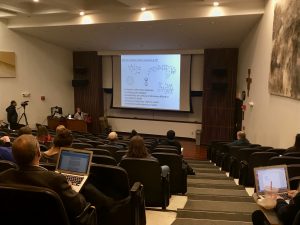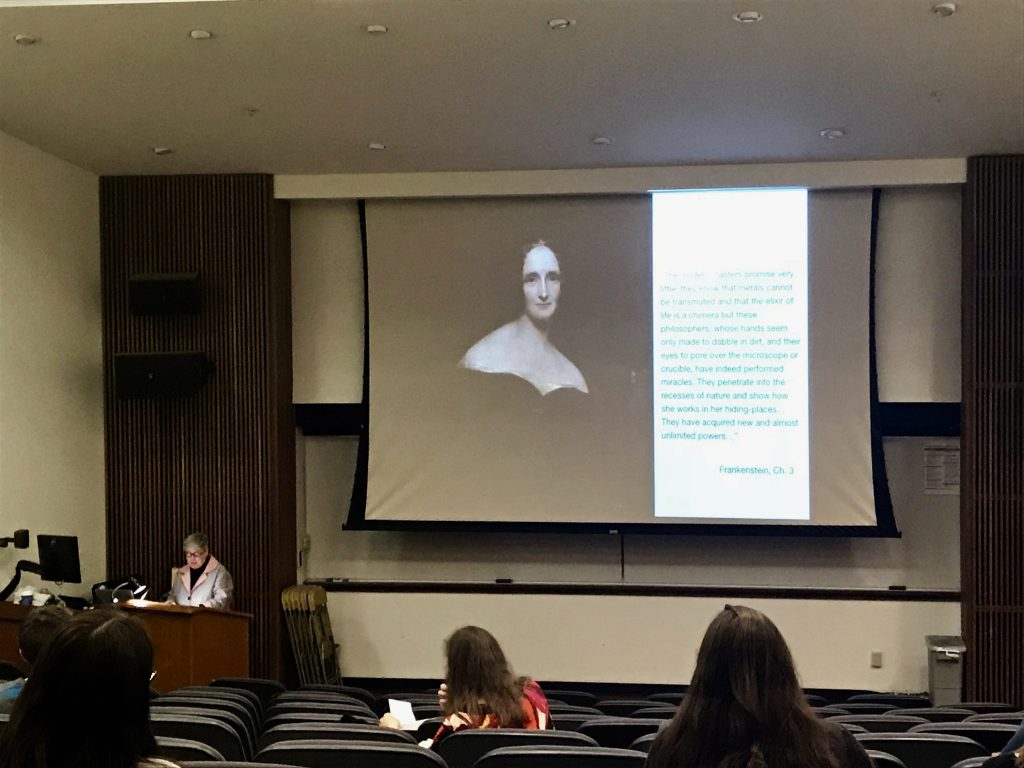Siena students and faculty jump-started the month of October by attending a lecture in the “Frankenstein: 200 Years of Fear and Thinking” series. Dr. Michelle Francl, quantum chemist, delivered a presentation titled “Making Molecular Monsters” on Monday, Oct. 1, 2018 in Roger Bacon Hall. Dr. Francl is an award-winning chemistry professor and chair of the Chemistry Department at Bryn Mawr College, as well as an adjunct scholar of the Vatican Observatory. Her areas of focus are in computational and theoretical chemistry. Dr. Francl was introduced by political science professor Dr. Laurie Naranch, who explained that the lecture is part of a series exploring “science, politics, knowledge, human responsibility, human capacity to destroy, and our ability to still experience wonder in relation to the world and the creatures that inhabit it.”
The lecture was a part of a larger series at Siena College celebrating the 200th anniversary of the publication of Mary Shelley’s “Frankenstein; or The Modern Prometheus.” “Frankenstein” narrates the story of Dr. Frankenstein, a young scientist who brings a monstrous creation to life and suffers the consequences of his scientific exploration. The novel explores themes of dangerous knowledge, the sublime, isolation and prejudice of the “other.” Shelley’s novel is a staple of many English classes and First Year Seminar students read Gris Grimley’s graphic novel of “Frankenstein,” as well as discussed the themes and lasting impacts of the novel.
“It was interesting to think about how to connect chemistry and Frankenstein in a way that held together cohesively,” Dr. Francl said at the beginning of her lecture. “Chemistry plays a really significant role in the story. It sets into motion Frankenstein’s first steps into peril.” Dr. Francl further tied the creation of Frankenstein’s monster to chemists developing monstrous molecules. “I’m interested in molecules that misbehave, molecules that transgress the borders that chemists think exist for molecules,” she explained. “Over this forty-year career, what unifies it is thinking about what makes the molecule do the unexpected.”

Dr. Francl discussed transgressive molecules, questioning why chemists make “monstrous” molecules. When prompted why chemists make molecules at all, she showed a slide in her presentation listing the reasons: to learn to make more molecules, to produce pure simples, and for a fundamental understanding of matter. Dr. Francl also included that scientists make molecules to challenge, surprise and delight, as well as for the purposes of beauty and joy.
“What makes a molecule beautiful?” Dr. Francl asked. “People tend to think of chemistry as yucky.” She presented the audience with her “top ten beautiful molecules” and delved into the notion of pathological cases or “corner” cases in chemistry, situations occurring outside the traditional boundaries of science. In reference to a pathological molecule, Dr. Francl connected the term “pathological” to its origin phrase “pathos,” which refers to emotion or raw passion. “Chemists display enormous passion for the construction of challenging molecules,” she said. “The willingness to tackle the construction of these pathological molecules goes beyond the desire to know something about the chemical universe.”
Dr. Francl then played a clip from one of the many “Frankenstein” film adaptations. She showed the scene in which Dr. Frankenstein’s monster comes to life. “It’s alive!” the scientist screams triumphantly, in both awe and fear of his creation. “And now what I know what it feels like to be God,” Dr. Frankenstein says. Dr. Francl connected Dr. Frankenstein’s sentiments back to chemistry, explaining that the interest in monstrous molecules stems from “being able to dabble in the stuff of life and the universe and exercise control.” She concluded her lecture by discussing the importance of control and exploration, both in “Frankenstein” and in chemistry.
If students are interested in learning more about Dr. Francl’s professional and academic work, she posts regularly on the Catholic Astronomer, the Vatican Observatory Foundation blog. “Frankenstein: 200 Years of Fear and Thinking” will continue through the fall semester and interested students should keep an eye on the Student Digest and flyers around campus. On Halloween, there will be showings of Tim Burton’s “Frankenweenie” and Mel Brooks’ classic “Young Frankenstein.” There is also an upcoming play adaptation of “Frankenstein” by David Lane, directed by Tom Truss, that will run next month from November 8-17 in the Beaudoin Theater of Foy Hall.

